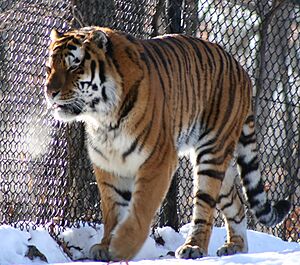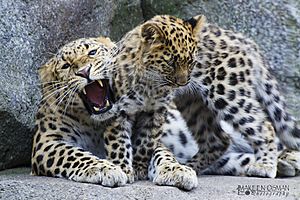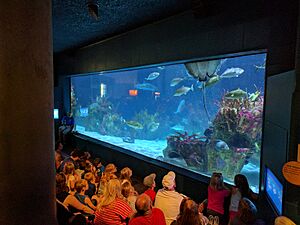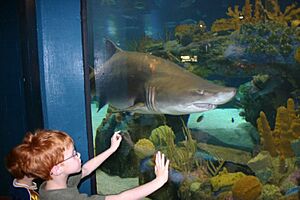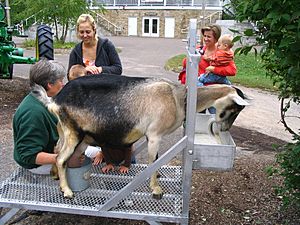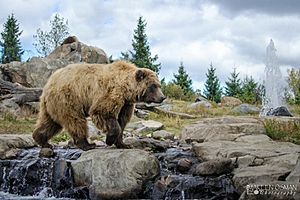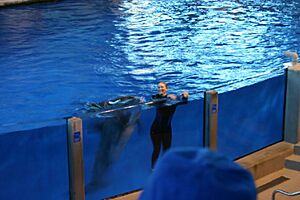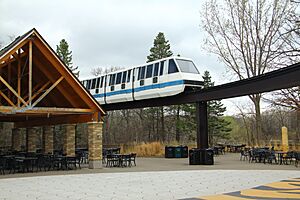Minnesota Zoo facts for kids
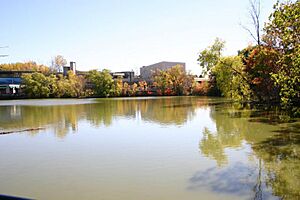 |
|
| Date opened | May 22, 1978 |
|---|---|
| Location | Apple Valley, Minnesota, United States |
| Land area | 485 acres (196 ha) |
| Coordinates | 44°46′07″N 93°11′56″W / 44.76861°N 93.19889°W |
| No. of animals | 4,509 (2019) |
| No. of species | 505 (2019) |
| Total volume of tanks | 1,100,000 US gallons (4,200,000 L) |
| Annual visitors | 1.3 million (2019) |
| Memberships | AZA, WAZA |
| Major exhibits | Discovery Bay, Family Farm, Grizzly Coast, Minnesota Trail, Northern Trail, Tropics Trail |
The Minnesota Zoo is a special place in Apple Valley, Minnesota. It's one of only two zoos in the United States that gets support from the state government. When it first opened on May 22, 1978, it was quite new and exciting! Instead of grouping animals by their type, the zoo organized them by where they live in the wild. This means you'll see animals from similar environments together.
The Minnesota Zoo is run by the state, which is different from most zoos that are managed by cities or private groups. You can buy tickets to visit or get an annual membership. The zoo is also home to a high school called the School of Environmental Studies.
Contents
- Explore the Minnesota Zoo's Amazing Exhibits
- The Minnesota Trail: Meet Local Animals
- Northern Trail: Animals from Cold Climates
- Tropics Trail: A Rainforest Adventure
- Discovery Bay: Underwater Wonders
- Wells Fargo Family Farm: Meet Farm Animals
- Russia's Grizzly Coast: Animals from Far East Russia
- 3M Penguins of the African Coast
- Other Fun Attractions at the Zoo
- Past Exhibits and What Happened
- In Popular Culture
Explore the Minnesota Zoo's Amazing Exhibits
The zoo has six main areas, including three walking trails. These trails are between one mile (1.6 kilometers) and two miles (3.2 kilometers) long. Get ready to explore:
- Medtronic Minnesota Trail: See animals that live right here in Minnesota.
- Northern Trail: Discover animals from cold, northern parts of the world.
- Tropics Trail: Step inside a warm, humid world filled with tropical animals.
- Discovery Bay: Explore an underwater world with marine animals.
- Russia's Grizzly Coast: Meet animals from Russia's Far East.
- Wells Fargo Family Farm: Get up close with friendly farm animals.
The Minnesota Trail: Meet Local Animals
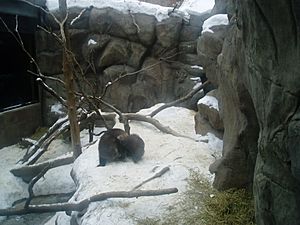
The Medtronic Minnesota Trail shows off animals that call Minnesota home. This trail got a big makeover in 2007. Now, it looks like a "north woods" forest! You can see raccoons, coyotes, and gray wolves, along with animals like beavers, otters, pumas, and lynx. Smaller Minnesota animals, such as turtles, frogs, and salamanders, live in a special "lodge" area at the start of the trail.
This quarter-mile (400-meter) trail lets you see over fifteen different animal exhibits. You'll walk through various Minnesota landscapes, from beaver ponds to northern forests. The Minnesota Zoo even won an award for this amazing trail in 2008!
Animals you might see here include:
- American black bear (Ursus americanus)
- American toad (Anaxyrus americanus)
- Bald eagle (Haliaeetus leucocephalus)
- Canada lynx (Lynx canadensis)
- Common mudpuppy (Necturus maculosus)
- Coyote (Canis latrans)
- Fisher (Martes pennanti)
- Gray wolf (Canis lupus)
- Great horned owl (Bubo virginianus)
- North American beaver (Castor canadensis)
- North American porcupine (Erethizon dorsatum)
- North American river otter (Lontra canadensis)
- Northern leopard frog (Lithobates pipiens)
- Puma (Puma concolor)
- Wolverine (Gulo gulo)
Northern Trail: Animals from Cold Climates
The 3/4-mile (1.21-kilometer) Northern Trail features animals that live in northern regions, above the 45th parallel. You could even see parts of this trail from the zoo's old monorail track, which is now the Treetop Trail!
Animals living in this area include:
- American bison (Bison bison)
- Amur tiger (Panthera tigris tigris)
- Bactrian camel (Camelus bactrianus)
- Black-tailed prairie dog (Cynomys luvodicianus)
- Boreal woodland caribou (Rangifer tarandus caribou)
- Dhole (Cuon alpinus lepturus)
- Llama (Lama glama)
- Moose (Alces alces)
- Pronghorn (Antilocapra americana)
- Przewalski's horse (Equus ferus przewalskii)
- Sichuan takin (Budorcas taxicolor tibetana)
You might have heard that muskoxen used to live on the Northern Trail. They were here from the zoo's opening until 2021. The zoo stopped their breeding program around 2011 because Minnesota's warmer summers were making it hard for the muskoxen to stay healthy. The last two older muskoxen were humanely put to sleep in April 2021.
Tropics Trail: A Rainforest Adventure
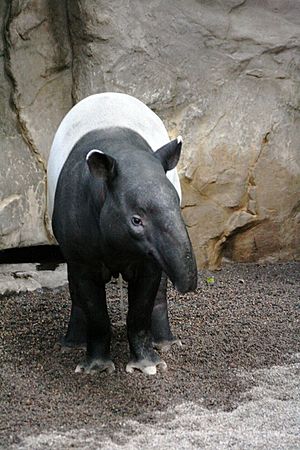
The Tropics Trail is an indoor trail that makes you feel like you're walking through a real tropical rainforest. It's warm and humid, just like the tropics!
Some of the animals you can find here are:
- Asian forest tortoise (Manouria emys)
- Bali myna (Leucopsar rothschildi)
- Bernier's teal (Anas bernieri)
- Burmese python (Python bivittatus)
- Common shelduck (Tadorna tadorna)
- Crested oropendola (Psarocolius decumanus)
- De Brazza's monkey (Cercopithecus neglectus)
- Demoiselle crane (Grus virgo)
- Dwarf crocodile (Osteolaemus tetraspis)
- Eastern black-and-white colobus (Colobus guereza)
- Freckled duck (Stictonetta naevosa)
- Garganey (Spatula querquedula)
- Golden lion tamarin (Leontopithecus rosalia)
- Great argus (Argusianus argus)
- Henkel's leaf-tailed gecko (Uroplatus henkeli)
- Indian star tortoise (Geochelone elegans)
- Komodo dragon (Varanus komodoensis)
- Lesser flamingo (Phoeniconaias minor)
- Linnaeus's two-toed sloth (Choloepus didactylus)
- Long-haired fruit bat (Stenonycteris lanosus)
- Malayan tapir (Tapirus indicus)
- Northern white-cheeked gibbon (Nomascus leucogenys)
- Oriental magpie-robin (Copsychus saularis)
- Radiated tortoise (Astrochelys radiata)
- Red river hog (Potamochoerus porcus)
- Rhinoceros hornbill (Buceros rhinoceros)
- Ring-tailed lemur (Lemur catta)
- Silvery lutung (Trachypithecus cristatus)
- Southern tamandua (Tamandua tetradactyla)
- Southern three-banded armadillo (Tolypeutes tricinctus)
- Sri Lankan junglefowl (Gallus lafayettii)
- Straw-coloured fruit bat (Eidolon helvum)
- Urial (Ovis vignei)
- Victoria crowned pigeon (Goura victoria)
Discovery Bay: Underwater Wonders
Discovery Bay is home to several large aquariums, holding a total of 1.1 million gallons (4.1 million liters) of water! Here, you can even touch sharks, rays, sea stars, and sea anemones in special interactive pools. Near the entrance to the Tropics building, look for a huge mural called "Our Ocean Family" by artist Wyland.
Animals you might see in Discovery Bay include:
- Atlantic goliath grouper (Epinephelus itajara)
- Atlantic tarpon (Megalops atlanticus)
- Florida pompano (Trachinotus carolinus)
- Green moray (Gymnothorax funebris)
- Green sea turtle (Chelonia mydas)
- Hawaiian monk seal (Neomonachus schauinslandi)
- Horn shark (Heterodontus francisci)
- Kemp's ridley sea turtle (Lepidochelys kempii)
- Leafy seadragon (Phycodurus eques)
- Leopard shark (Triakis semifasciata)
- Lined seahorse (Hippocampus erectus)
- Queen triggerfish (Balistes vetula)
- Sand tiger shark (Carcharias taurus)
- Southern stingray (Dasyatis americana)
- Weedy seadragon (Phyllopteryx taeniolatus)
Wells Fargo Family Farm: Meet Farm Animals
The Wells Fargo Family Farm opened in May 2000. It's a great place to touch and learn about domestic animals. You can see goats, sheep, pigs, cows, chickens, and horses in a lovely farm setting. This exhibit is open seasonally, usually from April until the fall. A popular event called "Farm Babies" kicks off the season each year. You might even get to watch the staff milk the cows!
Russia's Grizzly Coast: Animals from Far East Russia
Russia's Grizzly Coast lets you see animals that live along Russia's Pacific coast. This includes sea otters, brown bears, Amur leopards, and wild boars. Their habitats at the zoo are designed to look like their homes in the Russian Far East. This exhibit opened in June 2008 and was a very big project for the zoo.
3M Penguins of the African Coast
On July 9, 2011, the zoo opened a new exhibit featuring African penguins. These lively birds are always fun to watch!
Other Fun Attractions at the Zoo
Near the zoo's entrance, you'll find an exhibit for Japanese macaques, also known as snow monkeys. There's also an outdoor amphitheater where you can watch amazing bird shows during the summer. In the evenings, the amphitheater hosts popular "Music in the Zoo" concerts. Don't forget to check out the conservation carousel! This ride has 56 different animal figures from all over the world. You'll need zoo admission to ride it.
Past Exhibits and What Happened
The Minnesota Zoo has changed over the years, with some exhibits closing to make way for new ones.
Beluga Whales
One of the first and most popular exhibits at the zoo featured beluga whales. The zoo was home to two belugas, a male named Anookalik (nicknamed "Big Mouth") and a female named Anana (nicknamed "Little Girl"). Due to health issues, both whales were moved to SeaWorld San Diego for better care. In April 1987, nearly 30,000 people came to say goodbye to the whales before they left.
Dolphins
Dolphins were a part of the zoo from its opening in 1978 until 2012. The area where the dolphins lived is now home to Hawaiian monk seals. Over the years, many dolphins lived at the zoo, including some who were born there. For example, in 1992, a dolphin named Rio gave birth to the zoo's first successful captive-born dolphin, a male named "Shadow."
In 2011, the dolphin shows at the zoo paused. The zoo decided to permanently end the dolphin exhibit in May 2012. The two remaining dolphins, Semo and Allie, were moved to other zoos where they could have a better life. Semo, who was nearly 50 years old, was one of the oldest male dolphins in human care.
However, dolphins made a temporary return to the Minnesota Zoo in November 2022! Allie, along with six other bottlenose dolphins from the Brookfield Zoo, stayed in the Discovery Bay tank for several months. They returned to their home at the Brookfield Zoo in the spring of 2024.
Monorail
The zoo's monorail, called the Northern Trek Monorail, opened in September 1979. It had a few incidents over the years, including times when it stalled or had electrical issues. The monorail system continued to operate until it officially closed on September 2, 2013.
The old monorail track sat empty for a while. But in 2019, the zoo announced exciting news: they would build the Treetop Trail walkway right over the existing track! This new elevated walkway is 1.25 miles (2 kilometers) long, making it the world's longest. Construction started in April 2022 and was finished in the summer of 2023.
IMAX Theater
The Great Clips IMAX Theatre used to be located on the zoo grounds. It was once the largest IMAX theater in Minnesota, standing seven stories tall! The theater closed permanently on January 27, 2019. The zoo and IMAX had worked together, with the zoo showing nature documentaries and IMAX showing regular movies.
In Popular Culture
In 1987, the zoo was used as a filming location for "All About Animals." This was an educational children's video from the "Little Schoolhouse" series.


